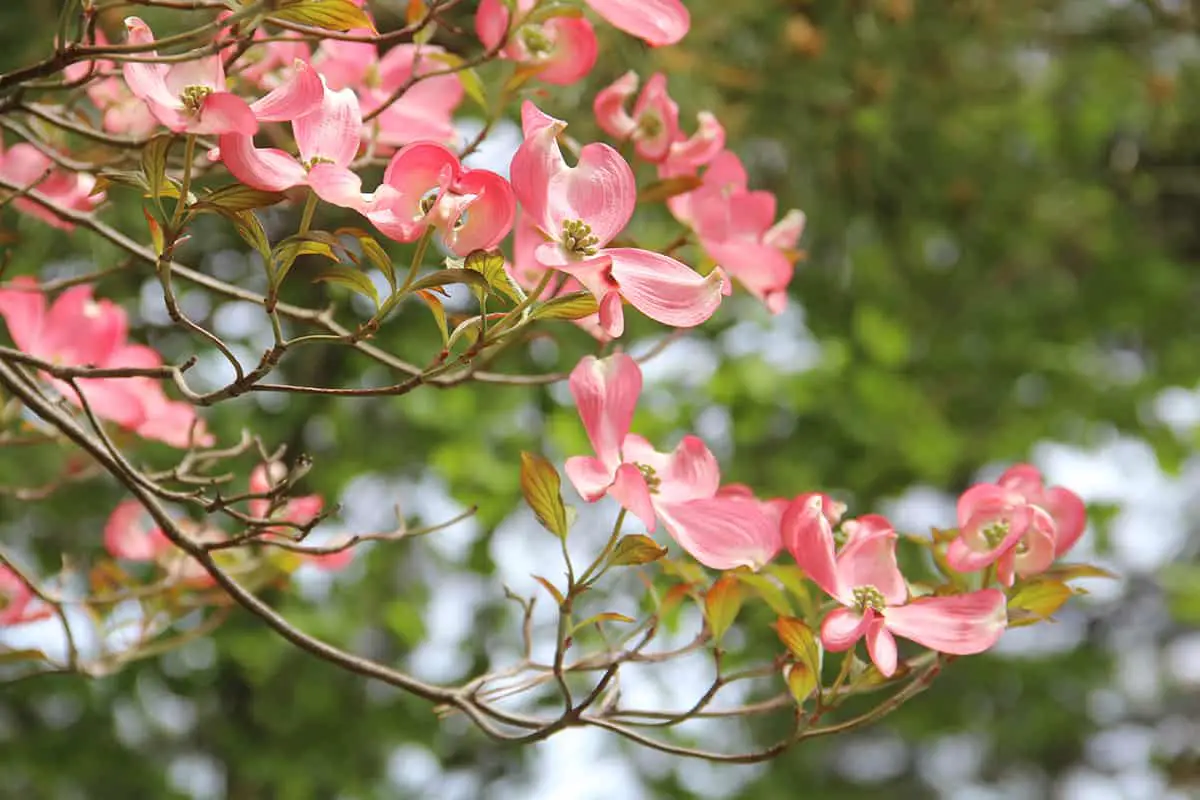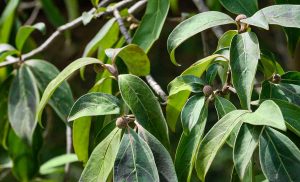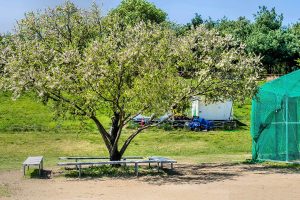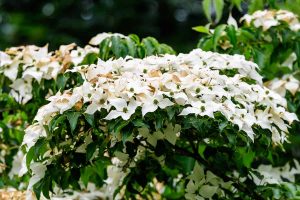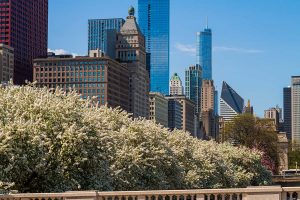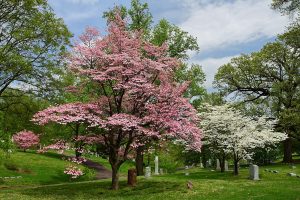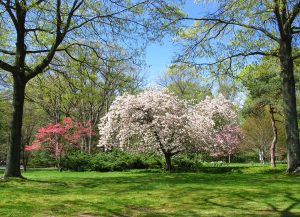Dogwood trees are a flowering species that are highly regarded for their ability to add interest to the landscape throughout every season. Throughout spring, dogwood trees flower with blooms, most commonly appearing in shades of white and cream.
There are also a number of dogwood trees that produce pink flowers, adding a bold color to the tree, which contrasts beautifully against the green foliage. If you’re looking for a pink flowering dogwood tree, consider one of these varieties.
Table of Contents
Pink Flowering Dogwood Trees
The pink ‘flowers’ on dogwood trees are not actually flowers at all. Instead, they are bracts that surround the true, less showy flowers of the tree. The true flowers are typically green or yellow; however, here, we will regard the bracts as parts of the flower.
Flowering Dogwood ‘Cherokee Chief’
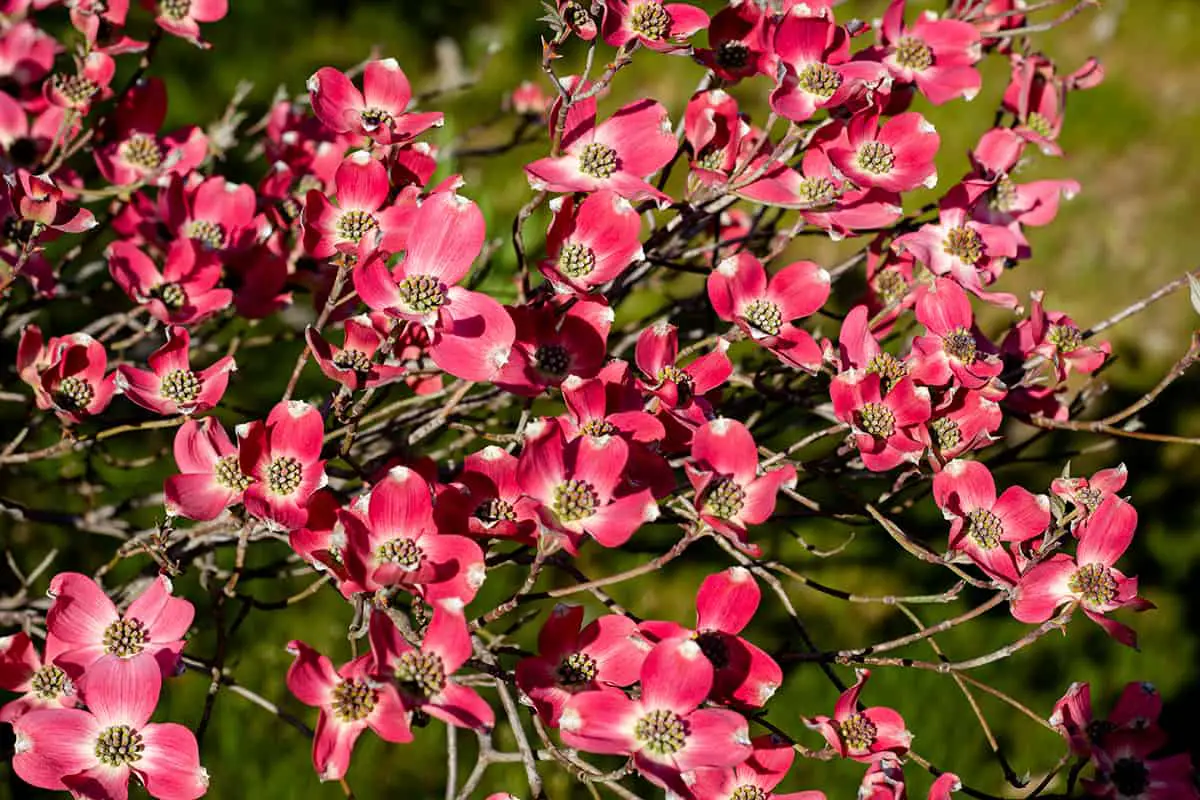
- Botanical name: Cornus florida ‘Cherokee Chief’
- Common names: Flowering Dogwood, Eastern Flowering Dogwood, Cherokee Chief
- Plant family: Cornaceae
- USDA hardiness zone: 5 – 9
- Mature height: 20 to 25 feet
- Mature spread: 12 to 18 feet
This variety of Flowering dogwood is loved for its bright pink flowers, which appear on bare branches before the emergence of the leaves in spring. Each flower is composed of four leaf bracts which are commonly mistaken for petals. These leaf bracts are shaped like a star, taking a flat form and measuring around four inches across.
The true flowers of this dogwood tree are barely noticeable, taking the shape of tiny yellow-green buds clustered in the middle of the pink leaf bracts. Each flower blooms at the end of a twig or branch of the tree, giving the impression that it is entirely clothed in color.
If you are looking for some dogwood trees with red berries, this is one of them. The flowers give way to bright, glossy red berries in summer, which add further interest and color to the landscape. These berries are enormously popular with birds and may be completely ravished before the summer is out. However, they are able to remain on the tree right into fall if they are not consumed beforehand.
The foliage of this tree is green through spring and summer, turning to impressive shades of red and purple in the fall, before dropping to the ground. In winter, when the tree is bare, the bark takes center stage. The bark is smooth and gray when the tree is young, but as it ages, it takes on a deeper gray color with an alligator skin texture.
While many Flowering dogwood trees are vulnerable to anthracnose disease and powdery mildew, the Cherokee Chief is known as one of the most disease-resistant varieties. This is a great specimen to choose if your local region typically suffers from diseased dogwood. It also has a higher tolerance to heat than many other Flowering dogwoods, making it well-suited to warmer climates.
Flowering Dogwood ‘Cherokee Sunset’
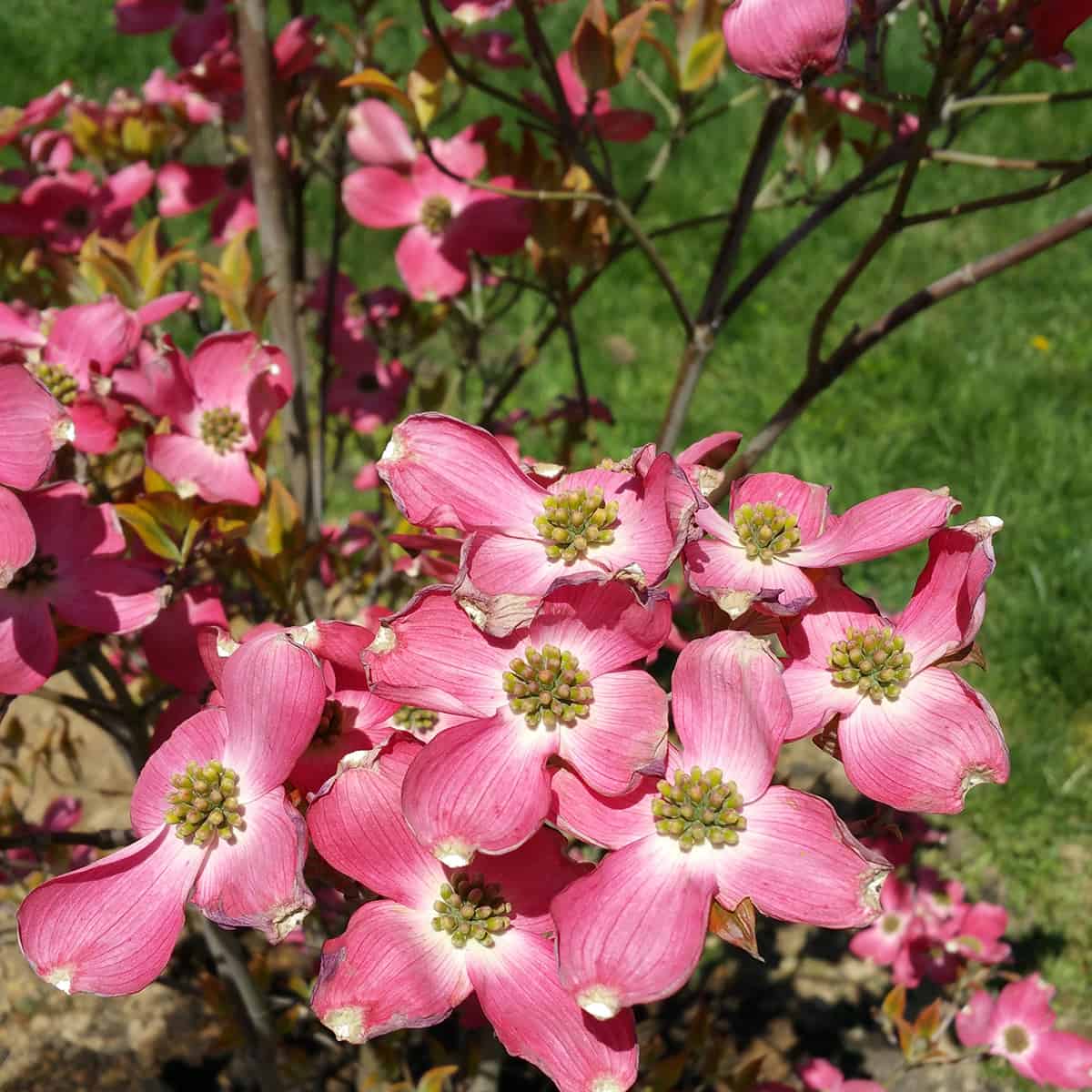
- Botanical name: Cornus florida ‘Cherokee Sunset’
- Common names: Flowering Dogwood, Eastern Flowering Dogwood, Cherokee Sunset
- Plant family: Cornaceae
- USDA hardiness zone: 5 – 9
- Mature height: 20 to 25 feet
- Mature spread: 20 to 25 feet
This is an especially attractive variety of Flowering dogwood, with elegant pink flowers and variegated vibrant leaves. The branches grow horizontally to form a rounded, evenly symmetrical canopy. The flowers emerge in spring before the emergence of leaves. The true flowers are tiny yellow mounds that are not noteworthy, but these are surrounded by delicately curving white bracts which are striped with dark pink.
The stripes become so dense at the tips of the bracts that they appear completely pink. Each bloom has four pointed bracts, giving the effect of dainty, curled stars. These flowers are followed by glistening red berries in the summer, which provide an important source of food for local wildlife.
The leaves of the ‘Cherokee Sunset’ are also a point of interest, as they emerge with subtle pink margins. They develop into variegated leaves featuring bright green color along the central vein, with yellow margins. The canopy looks vibrant through summer and takes on vivid shades of pink, red, and purple in the fall before the leaves are shed.
Unlike most Flowering dogwood species, the Cherokee Sunset is resistant to disease and pest infestations. It is also resistant to deer and has a higher tolerance to heat compared with other types of Flowering dogwood. It thrives in moist, well-draining soil, which is neutral to acidic. Roots are shallow and prefer to be kept cool in the summer, which can be achieved with mulching. The tree grows well in full sun or partial shade, though partial shade is preferred.
Kousa Dogwood ‘Miss Satomi’
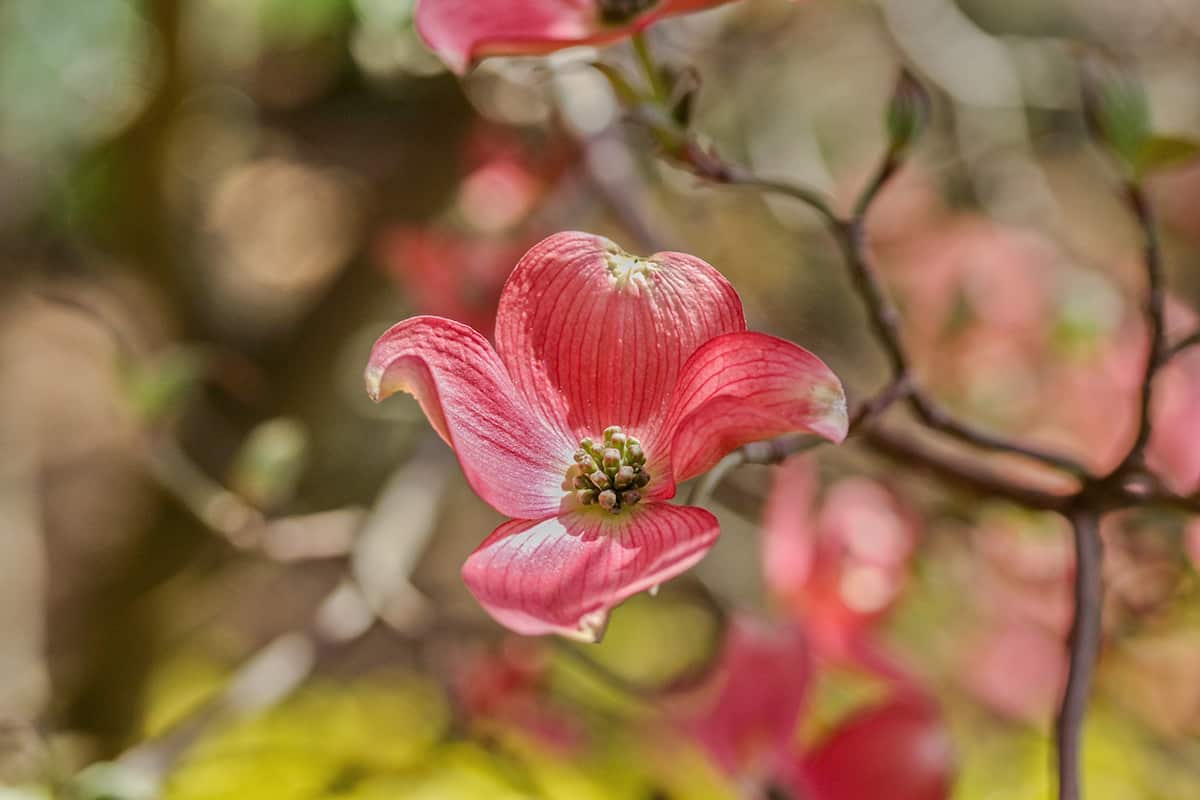
- Botanical name: Cornus kousa ‘Miss Satomi’
- Common names: Kousa Dogwood, Japanese Dogwood, Miss Satomi
- Plant family: Cornaceae
- USDA hardiness zone: 5 – 8
- Mature height: 12 to 15 feet
- Mature spread: 12 to 15 feet
This dogwood most commonly takes the shape of a shrub, gaining up to 15 feet in height with a similar-sized spread. ‘Miss Satomi’ is an award-winning variety of Kousa dogwood, which received the Award of Garden Merit from the Royal Horticultural Society for its notable qualities. It produces an abundance of star-shaped blooms in spring, which are heavily mottled with dark pink. The true flowers are a vivid shade of lime green, surrounded by pink leaf bracts.
The combination of these two contrasting colors makes for a bright and interesting look on the plant. The flowers give way to unusual berries in summer, which are spherical in shape, hanging from the dogwood-like baubles on a Christmas tree. The berries are a soft pink color and have a texture similar to that of strawberries.
They are very popular amongst birds. The foliage of the tree unfurls after the flowers have appeared in spring, in a medium shade of deep green. These develop to red in the fall, putting on a vibrant autumnal display. After the leaves have dropped from the tree, the exfoliating bark is revealed to retain interest through every season.
Kousa Dogwood ‘Scarlet Fire’
- Botanical name: Cornus kousa ‘Scarlet Fire’
- Common names: Kousa Dogwood, Japanese Dogwood, Scarlet Fire
- Plant family: Cornaceae
- USDA hardiness zone: 5 – 8
- Mature height: 20 to 25 feet
- Mature spread: 15 to 20 feet
This is a compact deciduous dogwood tree, which is known for its prolific ability to bloom. It is a very new variety, which was created in 2016 at the breeding programme at Rutgers University in New Jersey, USA. The flowers emerge in spring and last for as long as eight weeks, putting on a spectacular display of color.
The flowers each have four leaf bracts (commonly mistaken for petals), which are a bright fuchsia pink color and spread out into a star shape. At the center of the leaf bracts are clusters of true flowers in lime green. Each bloom will measure between four and five inches, and they flower on such a scale that the tree looks completely covered in pink.
In summer, the flowers will give way to berries that look similar to strawberries and are a popular source of food for birds. If they do not get eaten, they can remain on the tree to add extra interest right into fall. The leaves of the tree are dark green and flushed with a violet shade of purple when they first emerge.
In fall, the foliage develops to rich shades of orange and red before dropping to the ground. At this stage of the season, the skeleton of the small tree is revealed, and the exfoliating bark is on display. The bark can be gray, tan, or mottled, depending on the age of the tree.
Pink Flowering Dogwood
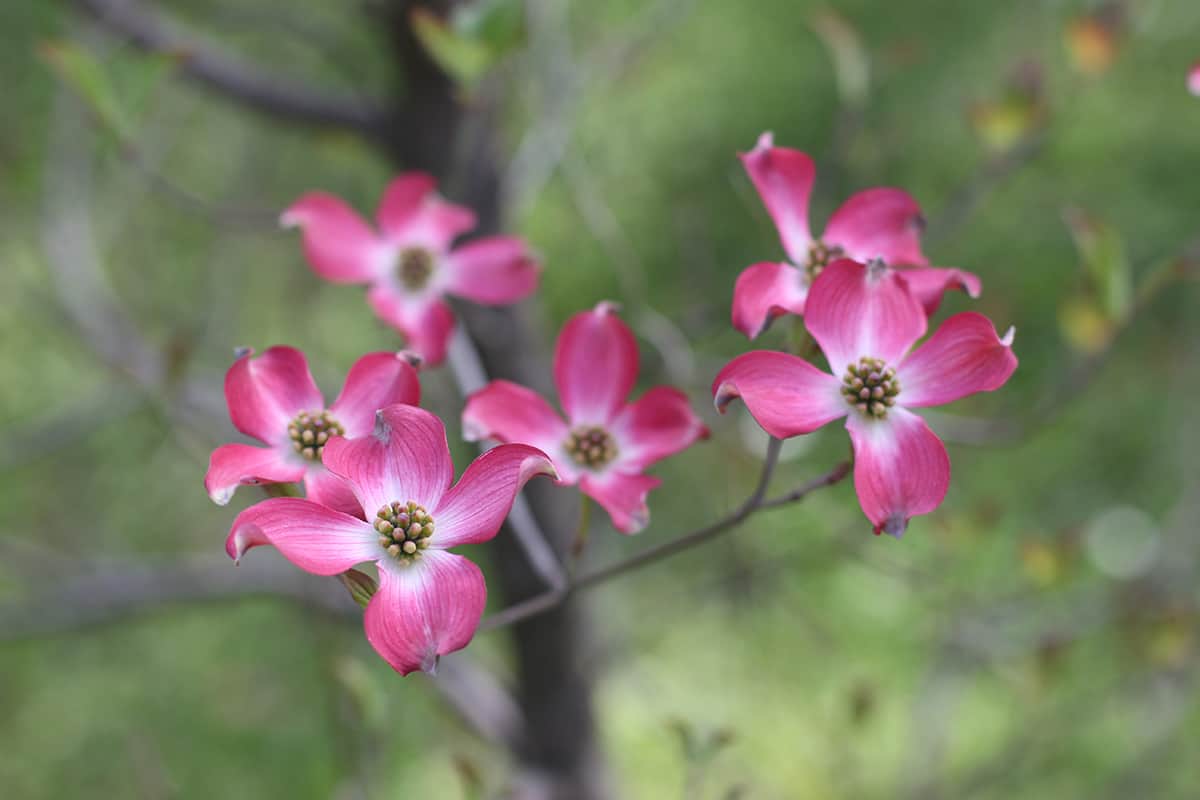
- Botanical name: Cornus florida f. rubra
- Common names: Flowering Dogwood, Eastern Flowering Dogwood, Pink Flowering Dogwood
- Plant family: Cornaceae
- USDA hardiness zone: 5 – 9
- Mature height: 15 to 30 feet
- Mature spread: 15 to 30 feet
The Pink Flowering dogwood tree is a deciduous specimen that has a broadly pyramidal shape. It blooms in spring, with flowers appearing on bare branches before the foliage has had a chance to unfurl. The true flowers are tiny green buds arranged in tight clusters, flushed with pink. These are surrounded by colorful leaf bracts in the shape of stars.
Each leaf bract, which looks like a petal, has a pinched tip which gives it an unusual shape. The bracts are white with heavy pink striping, giving the effect that they are entirely pink. The flowers measure between three and four inches across and bloom prolifically throughout spring. In summer, the flowers develop into fruits.
These are orange-red berries with a glossy outer texture, which get quickly devoured by birds. The canopy of the tree provides excellent shade through summer since the spread will be roughly equal to the height of the tree.
The leaves are green in spring and summer, developing to red and burgundy in the fall. In winter, the bark of the tree will be on display. On young dogwood trees, the bark is smooth and pale gray, and this takes on a darker coloring with an alligator skin pattern as it ages.
